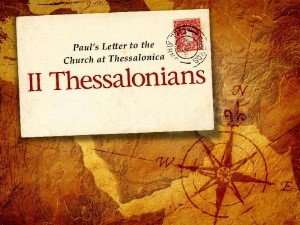 The next book after Luke-Acts in a chronologically ordered New Testament (NT), is second Thessalonians. Paul’s first letter to the Christ-community in Thessalonica in northern Greece is the earliest document in the NT, but this letter is one of the disputed letters of Paul. The majority of mainstream scholars do not think it was written by Paul, but by someone writing in his name some three to four decades after his death in the 60s.
The next book after Luke-Acts in a chronologically ordered New Testament (NT), is second Thessalonians. Paul’s first letter to the Christ-community in Thessalonica in northern Greece is the earliest document in the NT, but this letter is one of the disputed letters of Paul. The majority of mainstream scholars do not think it was written by Paul, but by someone writing in his name some three to four decades after his death in the 60s.
Because this letter echoes the structure and language of the first letter, a minority of scholars think this suggests that Paul wrote it down soon after his first letter. But a majority of scholars think that the similarities are a conscious and deliberate imitation the first letter by an author writing in Paul’s name around the year 100 or soon thereafter. The letter addresses two questions that belong to a time period later than Paul: the delay of the second coming of Jesus and the issue of “freeloaders” – people who became part of the Christ-community not because they were passionate about Jesus, but in order to receive free food.
After an opening greeting and thanksgiving similar to those in the first letter, it continues with an explanation of why the second coming of Jesus has not yet happened. Recall that Paul in his first letter expected Jesus to return soon. But this letter affirms that there are events that must happen first: the “rebellion,” and the revelation of the “lawless one” who “opposes and exalts himself above every so-call god” and “takes his seat in the temple of God, declaring himself to be God.” Though the recipients of the letter most likely understood what the author was writing about, we do not. Was he writing about Roman soldiers offering sacrifices to the emperor in the temple after they had conquered Jerusalem in the year 70? Or about an event that had not happened yet? In either case, the situation reflects a time after Paul’s death. The broader point is that there are still things that must happen before the second coming.
The issue of the freeloaders is addressed in the last chapter of this letter. The issue arises in any religious movement that is made up of “share communities,” those that provide the material basis of existence for its members.
The problem of the authorship of this letter has not disproved the authenticity of its content. The letter has great doctrinal value, revealing as it does the faith of the community. It’s short, only three chapters long.
